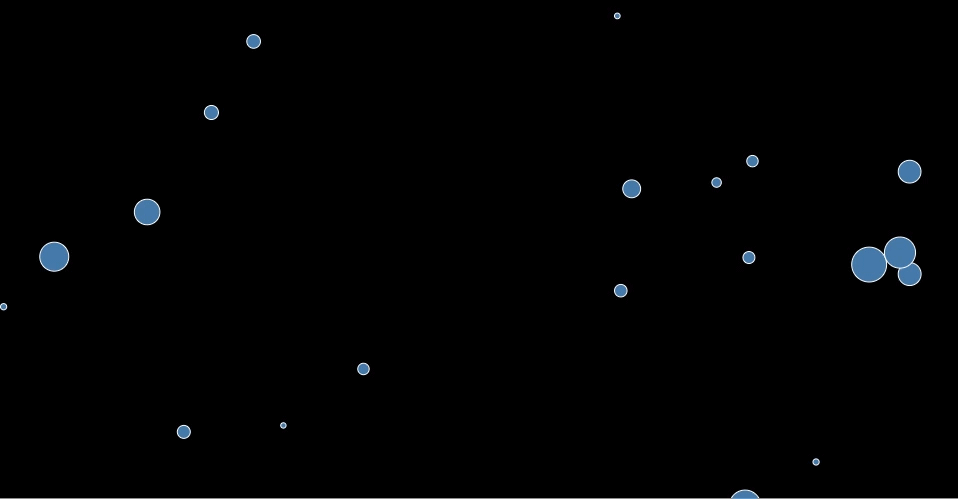Harry Stevens has only been at The Washington Post for six months, but he’s responsible for what might be one of the most-read articles on the news site.
“Why outbreaks like coronavirus spread exponentially, and how to ‘flatten the curve’,” a wonky visual explainer of how a simulated virus spreads through human contact, was published March 14. Since then, former President Barack Obama tweeted the story to his 114 million followers, generating more than 122,000 retweets, and Venezuelan President Nicolas Maduro showed its graphics on state television.
Washington Post media reporter Paul Farhi tweeted that he heard the story was the most-read in the website’s history, even eclipsing the article about the Donald Trump “Access Hollywood” tape. And the Post has translated the piece into Spanish and Italian, with several more languages to come.
“It’s orders of magnitude more successful than anything I’ve ever made before, and it feels like catching lightning in a bottle,” said Stevens, who previously worked at Axios and Hindustan Times.
The article charts the course of a hypothetical virus called “simulitis” through a town of 200 people, who are represented by bouncing dots. It shows how something like the coronavirus spreads exponentially through network effects and illustrates the efficacy of “social distancing” — its strength is in its simplicity.
In four scenarios — free-for-all, attempted quarantine, moderate distancing and extensive distancing — the dots transmit the hypothetical virus to one another and create a graph showing the number of infected over time for each.
The Post published the story on a day when social media users were shaming partiers who filled Chicago bars to pre-celebrate St. Patrick’s Day against pleas from officials, and a few days after every major sports league canceled or delayed seasons.
Stevens had been at work on the project for the previous two weeks, using a technique he dreamed up a year ago while messing around with code on the weekend. He had used JavaScript to create a bunch of random balls bouncing off of each other, and brought that idea to the Post graphics team as they sought a way to visualize the spread of coronavirus during an early March meeting.

An early prototype of the visual storytelling used in The Washington Post article “Why outbreaks like coronavirus spread exponentially, and how to ‘flatten the curve’.” (Courtesy: Harry Stevens/The Washington Post)
Stevens called a researcher at Johns Hopkins University who explained it would be impossible to illustrate her team’s complex models to map the spread of coronavirus — some of them require a computer program running overnight to build. So he stuck with the simple idea of balls moving about at random, which ended up looking similar to the actual worldwide curve for COVID-19.
“It actually mimicked reality so closely that people started to confuse these crude simulations of ‘simulitis’ with COVID-19,” Stevens said.
The project went through three major iterations. One used scrollytelling, in which chunks of text and graphics appear and disappear as a user scrolls, but it made the graphics hard to see. Another didn’t allow dots to recover from “simulitis,” which created a bleak runaway infection. Stevens landed on the final piece after collecting feedback from nearly a dozen people during the 40 to 50 hours it took to finish the article.
“Having people tell you that things don’t work can be really helpful,” he said.
Stevens is still responding to hundreds of messages received through email, Facebook, Twitter and LinkedIn, with many saying that the visualization — and seeing how social distancing can “flatten the curve” — actually quelled their anxiety about coronavirus.
“Honestly, I hadn’t internalized it until I saw the simulations, so it had the same effect on me that it had on readers,” Stevens said.
Still, he has fielded complaints from nitpickers saying the article didn’t make clear that it’s not modeling the coronavirus, or that the simulation didn’t show people dying from the hypothetical virus. The latter was a conscious choice: The graphics team didn’t want the visualizations to be needlessly grim with all those dots dying off.
The Post graphics team will continue to cover coronavirus in novel ways, Stevens said.
“Now every time I publish something my editors are going to wonder why Barack Obama didn’t tweet it,” he said.
Alex Mahadevan is a senior multimedia reporter at MediaWise. He can be reached at amahadevan@poynter.org or on Twitter at @AlexMahadevan. Follow MediaWise on TikTok.
"easy" - Google News
March 18, 2020 at 07:02PM
https://ift.tt/2QsCzQS
How a blockbuster Washington Post story made 'social distancing' easy to understand - Poynter
"easy" - Google News
https://ift.tt/38z63U6
Shoes Man Tutorial
Pos News Update
Meme Update
Korean Entertainment News
Japan News Update
Bagikan Berita Ini















0 Response to "How a blockbuster Washington Post story made 'social distancing' easy to understand - Poynter"
Post a Comment